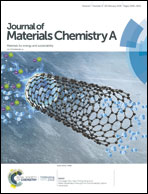Colored semitransparent polymer solar cells with a power conversion efficiency of 9.36% achieved by controlling the optical Tamm state†
Abstract
Semitransparent polymer solar cells (ST-PSCs) have become novel photovoltaic technologies because of their extensive applications such as in building integrated photovoltaics (BIPV); however, their power conversion efficiency (PCE) is still lagging behind that of opaque PSCs mainly due to insufficient light harvesting. Herein, we demonstrated high-efficiency ST-PSCs by controlling the optical Tamm state (OTS) formed at the interface between thin silver (Ag) electrodes and extra added layer (EAL)/one-dimensional photonic crystals (1DPCs). The transmission groove of Ag/EAL/1DPCs was gradually red-shifted and broadened by tuning the position and intensity of the OTS; this resulted in a PCE as high as 9.36 ± 0.16% and an average visible transmission (AVT) of 14.31 ± 0.65% in the visible range along with tailor-made color. Simulation results obtained by transfer matrix modeling (TMM) demonstrated that the photoelectric field intensity could be redistributed by controlling the OTS; this led to an enhancement in the absorption of the ST-PSCs. We believe that the light management method of controlling the OTS can have the significant promise to speed up the commercial applications of colorized ST-PSCs in BIPVs.



 Please wait while we load your content...
Please wait while we load your content...